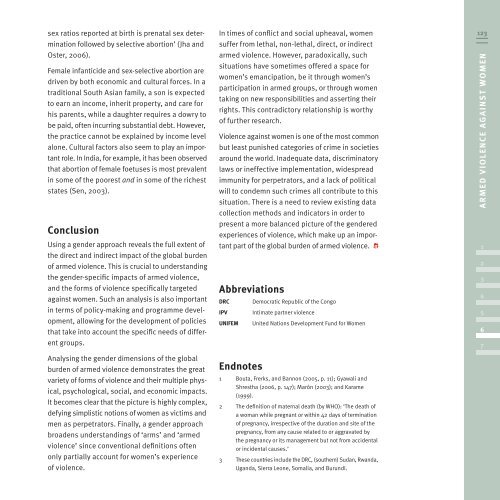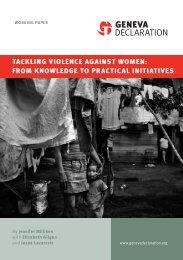Global Burden of Armed Violence - The Geneva Declaration on ...
Global Burden of Armed Violence - The Geneva Declaration on ...
Global Burden of Armed Violence - The Geneva Declaration on ...
Create successful ePaper yourself
Turn your PDF publications into a flip-book with our unique Google optimized e-Paper software.
sex ratios reported at birth is prenatal sex determinati<strong>on</strong><br />
followed by selective aborti<strong>on</strong>’ (Jha and<br />
Oster, 2006).<br />
Female infanticide and sex-selective aborti<strong>on</strong> are<br />
driven by both ec<strong>on</strong>omic and cultural forces. In a<br />
traditi<strong>on</strong>al South Asian family, a s<strong>on</strong> is expected<br />
to earn an income, inherit property, and care for<br />
his parents, while a daughter requires a dowry to<br />
be paid, <str<strong>on</strong>g>of</str<strong>on</strong>g>ten incurring substantial debt. However,<br />
the practice cannot be explained by income level<br />
al<strong>on</strong>e. Cultural factors also seem to play an important<br />
role. In India, for example, it has been observed<br />
that aborti<strong>on</strong> <str<strong>on</strong>g>of</str<strong>on</strong>g> female foetuses is most prevalent<br />
in some <str<strong>on</strong>g>of</str<strong>on</strong>g> the poorest and in some <str<strong>on</strong>g>of</str<strong>on</strong>g> the richest<br />
states (Sen, 2003).<br />
C<strong>on</strong>clusi<strong>on</strong><br />
Using a gender approach reveals the full extent <str<strong>on</strong>g>of</str<strong>on</strong>g><br />
the direct and indirect impact <str<strong>on</strong>g>of</str<strong>on</strong>g> the global burden<br />
<str<strong>on</strong>g>of</str<strong>on</strong>g> armed violence. This is crucial to understanding<br />
the gender-specific impacts <str<strong>on</strong>g>of</str<strong>on</strong>g> armed violence,<br />
and the forms <str<strong>on</strong>g>of</str<strong>on</strong>g> violence specifically targeted<br />
against women. Such an analysis is also important<br />
in terms <str<strong>on</strong>g>of</str<strong>on</strong>g> policy-making and programme development,<br />
allowing for the development <str<strong>on</strong>g>of</str<strong>on</strong>g> policies<br />
that take into account the specific needs <str<strong>on</strong>g>of</str<strong>on</strong>g> different<br />
groups.<br />
Analysing the gender dimensi<strong>on</strong>s <str<strong>on</strong>g>of</str<strong>on</strong>g> the global<br />
burden <str<strong>on</strong>g>of</str<strong>on</strong>g> armed violence dem<strong>on</strong>strates the great<br />
variety <str<strong>on</strong>g>of</str<strong>on</strong>g> forms <str<strong>on</strong>g>of</str<strong>on</strong>g> violence and their multiple physical,<br />
psychological, social, and ec<strong>on</strong>omic impacts.<br />
It becomes clear that the picture is highly complex,<br />
defying simplistic noti<strong>on</strong>s <str<strong>on</strong>g>of</str<strong>on</strong>g> women as victims and<br />
men as perpetrators. Finally, a gender approach<br />
broadens understandings <str<strong>on</strong>g>of</str<strong>on</strong>g> ‘arms’ and ‘armed<br />
violence’ since c<strong>on</strong>venti<strong>on</strong>al definiti<strong>on</strong>s <str<strong>on</strong>g>of</str<strong>on</strong>g>ten<br />
<strong>on</strong>ly partially account for women’s experience<br />
<str<strong>on</strong>g>of</str<strong>on</strong>g> violence.<br />
In times <str<strong>on</strong>g>of</str<strong>on</strong>g> c<strong>on</strong>flict and social upheaval, women<br />
suffer from lethal, n<strong>on</strong>-lethal, direct, or indirect<br />
armed violence. However, paradoxically, such<br />
situati<strong>on</strong>s have sometimes <str<strong>on</strong>g>of</str<strong>on</strong>g>fered a space for<br />
women’s emancipati<strong>on</strong>, be it through women’s<br />
participati<strong>on</strong> in armed groups, or through women<br />
taking <strong>on</strong> new resp<strong>on</strong>sibilities and asserting their<br />
rights. This c<strong>on</strong>tradictory relati<strong>on</strong>ship is worthy<br />
<str<strong>on</strong>g>of</str<strong>on</strong>g> further research.<br />
<str<strong>on</strong>g>Violence</str<strong>on</strong>g> against women is <strong>on</strong>e <str<strong>on</strong>g>of</str<strong>on</strong>g> the most comm<strong>on</strong><br />
but least punished categories <str<strong>on</strong>g>of</str<strong>on</strong>g> crime in societies<br />
around the world. Inadequate data, discriminatory<br />
laws or ineffective implementati<strong>on</strong>, widespread<br />
immunity for perpetrators, and a lack <str<strong>on</strong>g>of</str<strong>on</strong>g> political<br />
will to c<strong>on</strong>demn such crimes all c<strong>on</strong>tribute to this<br />
situati<strong>on</strong>. <str<strong>on</strong>g>The</str<strong>on</strong>g>re is a need to review existing data<br />
collecti<strong>on</strong> methods and indicators in order to<br />
present a more balanced picture <str<strong>on</strong>g>of</str<strong>on</strong>g> the gendered<br />
experiences <str<strong>on</strong>g>of</str<strong>on</strong>g> violence, which make up an important<br />
part <str<strong>on</strong>g>of</str<strong>on</strong>g> the global burden <str<strong>on</strong>g>of</str<strong>on</strong>g> armed violence.<br />
Abbreviati<strong>on</strong>s<br />
DRC Democratic Republic <str<strong>on</strong>g>of</str<strong>on</strong>g> the C<strong>on</strong>go<br />
IPV Intimate partner violence<br />
UNIFEM United Nati<strong>on</strong>s Development Fund for Women<br />
Endnotes<br />
1 Bouta, Frerks, and Bann<strong>on</strong> (2005, p. 11); Gyawali and<br />
Shrestha (2006, p. 147); Marón (2003); and Karame<br />
(1999).<br />
2 <str<strong>on</strong>g>The</str<strong>on</strong>g> definiti<strong>on</strong> <str<strong>on</strong>g>of</str<strong>on</strong>g> maternal death (by WHO): ‘<str<strong>on</strong>g>The</str<strong>on</strong>g> death <str<strong>on</strong>g>of</str<strong>on</strong>g><br />
a woman while pregnant or within 42 days <str<strong>on</strong>g>of</str<strong>on</strong>g> terminati<strong>on</strong><br />
<str<strong>on</strong>g>of</str<strong>on</strong>g> pregnancy, irrespective <str<strong>on</strong>g>of</str<strong>on</strong>g> the durati<strong>on</strong> and site <str<strong>on</strong>g>of</str<strong>on</strong>g> the<br />
pregnancy, from any cause related to or aggravated by<br />
the pregnancy or its management but not from accidental<br />
or incidental causes.’<br />
3 <str<strong>on</strong>g>The</str<strong>on</strong>g>se countries include the DRC, (southern) Sudan, Rwanda,<br />
Uganda, Sierra Le<strong>on</strong>e, Somalia, and Burundi.<br />
123<br />
A R M E D V I O L E N C E AG A I N S T WOMEN<br />
1<br />
2<br />
3<br />
4<br />
5<br />
6<br />
7









